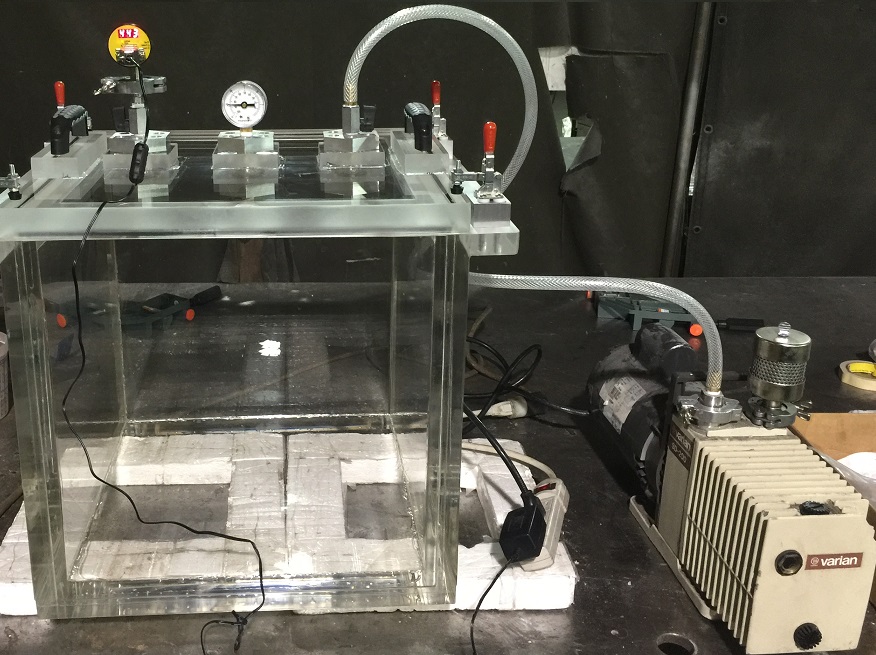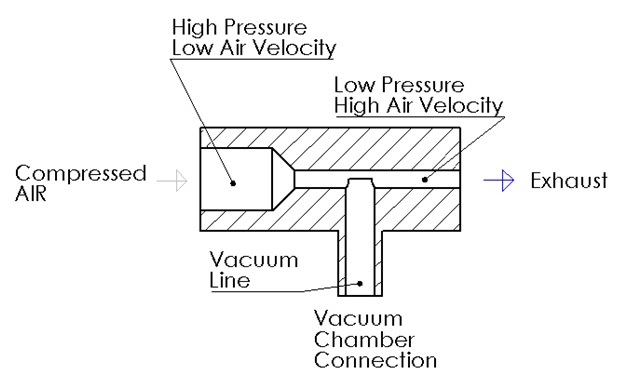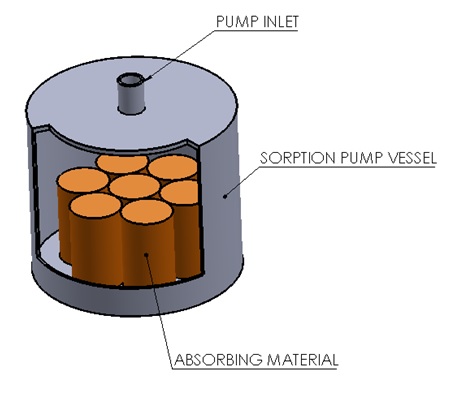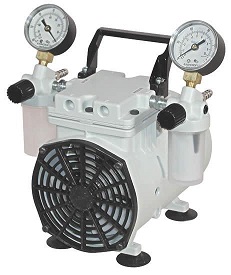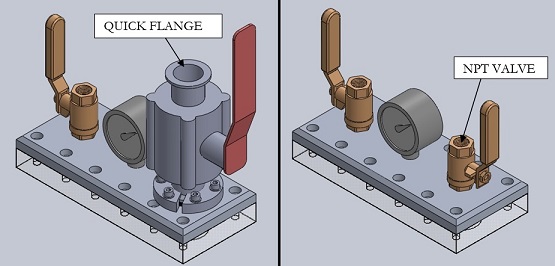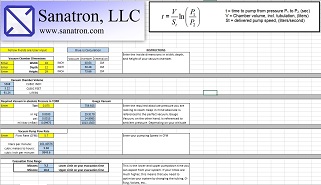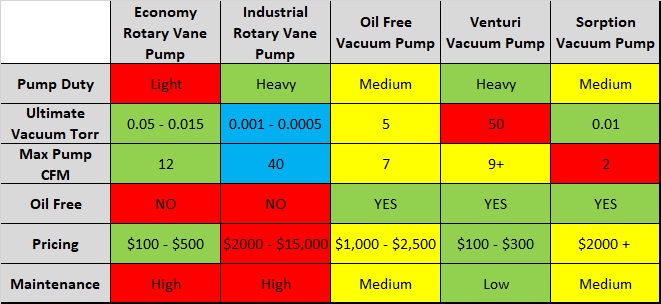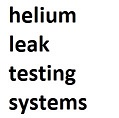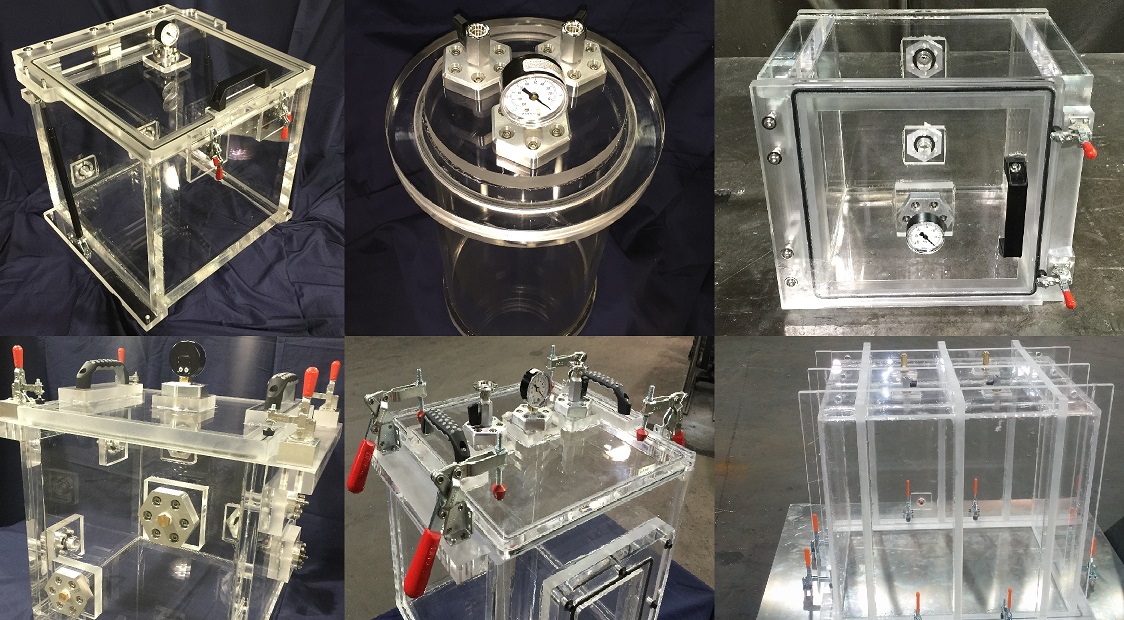In this article we will talk about Vacuum Pumps - but also about other equipment which is used to produce vacuum inside a closed system or chamber. We will talk about the workings of a vacuum pump, vacuum generation, pump down, pump horsepower. This article is intended to provide you a practical guide which should help you select the appropriate vacuum pump for your system.
Vacuum Pumps
In real simple laymen terms, a vacuum pump is a device which is capable of producing vacuum. A vacuum is a condition where the pressure is lower than the ambient pressure; hence there is a pressure difference between two systems. People often make the mistake of confusing a vacuum to an air pull, where in reality, a pull is the result of vacuum and not the condition itself. The "air pull" is created because the higher pressure system (ambient air) is flowing towards the lower pressure system (vacuum) due to pressure difference.
According to the Ideal Gas Law, the pressure is proportional to the number of molecules in an enclosed system. This means that a vacuum is created by removing the air molecules from an enclosed system such as an Acrylic Vacuum Chambers.
Classification of Vacuum Pumps
It would not be an overstatement to say that vacuum pumps come in all shapes and sizes and that we could go into pages and pages describing the workings of each type. However, and for practical reasons, we will keep this short and concise and concentrate only on pumps that are ideal for Acrylic Vacuum Chambers.
Rotary Vane Pump
A rotary vane pump is the most popular vacuum pump used today for various vacuum applications. There are literally hundreds of different vacuum pumps out there. Oil sealed Rotary Vane Vacuum pump are either one (single) stage or two (dual) stage.
Single Stage Rotary Vane Pump
The single stage vacuum pump has an eccentric rotor which is oil immersed. When the rotor turns, the vanes act as seals, by gliding against the inside of the housing wall and creating a positive displacement or vacuum. The ultimate vacuum rating of a single stage rotary vane vacuum pump is around 0.015 Torr (15 microns).
Dual Stage Rotary Vane Pump
A dual stage rotary vane pump operates in two stages. The first stage is the pump down stage while the second stage is the exhaust stage. This enables the dual stage vac pump to perform better at higher vacuums. In fact, the dual stage pump outperforms its single stage counterpart the higher the vacuum is - the higher the vacuum the better the outperformance. Additionally, the dual stage pump will go down to 0.001 Torr or 1 micron.
Advantages of Rotary Vane Pumps
The main advantage is that rotary vane pumps are very popular and common and can be purchased anywhere for any price. In addition, a rotary vane pump only requires electricity to run - all you have to do is plug it into electricity, flip a switch, and voila, you got yourself some pretty decent vacuum. Even a cheap two stage pump can reach vacuum levels of 100 microns; which is pretty impressive. The higher end models can reach 1 micron. A rotary vane pump is easy to maintain and to service.
Disadvantages of Rotary Vane Pumps
Rotary vane vacuum pumps can be somewhat loud. Vacuum pump oil can sometimes create a mess and be an inconvenience because you will have to maintain your pump and change the pump oil as needed. High end rotary vane pump models can cost you thousands of dollars while the cheap ones will go out on you after a few months use.
Another Disadvantage of a Rotary Vane Vacuum Pump is the Exhaust emissions. Since the oil is used to seal the vanes and to create a vacuum, internally oil mist will develop. This oil mist will then be exhausted and emitted into the vacuum pump surrounding. A Rotary Vane Pump may not be the ideal solution in clean rooms, closed rooms and laboratories, or medical, food, or FDA manufacturing environments. Fortunately, these exhaust gasses can be minimized by placing an exhaust filter onto the vacuum pump exhaust. Note that the exhaust will be minimized but not fully eliminated.
Finally, it should be noted that rotary vane pumps can be divided into two price categories, the Economy Rotary Vane Vacuum Pump which in most cases costs between $100 to $1000 and Industrial Rotary Vane Vacuum Pump which can cost somewhere between $1,500 to $15,000.
Aspirator Vacuum Pump - Venturi Pump
An aspirator vacuum pump is a device which produces vacuum by Ideal Gas Law. A Venturi effect produces a pressure difference by constraining, or slowing down the air molecules in a pipe, or system. This slowing down of air molecules causes the pressure to increase, if you connect an orifice to the larger diameter pipe and another orifice to the smaller diameter pipe, you essentially create a Venturi Pump - as simple as that.
Advantages of a Venturi Pump
The main advantage of a Venturi pump is that is it fairly cheap, "indestructible", and low maintenance - it is essentially a piece of metal which when hooked up to an air line, creates a vacuum.
Disadvantages of Venturi Pumps
The main disadvantage of the Venturi pump is that it requires compressed air to operate. Another disadvantage of a Venturi Pump is that fact that ultimate vacuum cannot go down below 40 Torr (40,000 micron) absolute pressure.
Sorption Vacuum Pump
A Sorption pump is made of an air absorbing material such Zeolite which is a porous material that has cavities small enough to trap air molecules such as Nitrogen, Oxygen, etc... The absorbing material is encased in a vessel. For a sorption pump to be effective, it must be cooled to lower, cryogenic temperatures which means that the vessel has to be immersed into a liquid nitrogen bath.
The best way to describe a sorption pump would be to imagine a bucket of water and a sponge; sponge representing absorbing material, water representing air, and the bucket representing your vacuum chamber. By dipping the sponge into the bucket, you essentially remove water from the bucket, hence creating vacuum. Sorption pumps usually go down to 0.1 Torr. Some types of specially designed Cryo-Sorption Pumps have the ability to go down to 0.00001 Torr or 0.01 micron.
Advantages of a Sorption Vacuum Pump
The main advantage of a sorption pump is that it has no moving parts and is essentially free of contaminants such as pump oil or debris. This pump is very clean and makes it an ideal choice where system cleanliness and being contamination free is critical.
Disadvantages of a Sorption Vacuum Pump
Obviously the main disadvantage of as sorption pump is the requirement for liquid nitrogen. Another disadvantage is that noble gases are not well absorbed by this type of pump. Lastly a sorption pump must be regenerated which means that it must be heated back up to room temperature in order to release the air molecules from the porous material once it gets saturated with air molecules.
Oil Free Vacuum Piston Pump
The Oil Free Vacuum Pump is used where no exhaust gases are permissible. Oil Free Vacuum Pumps are often used in laboratory environments and clean rooms.
Advantages of Oil Free Vacuum Piston Pump
An Oil free pump does not emit any oil mist or water mist into the room and therefore can be operated inside a closed room. The exhaust emitting from a rotary vane pump can build up and settle or deposit onto its surrounding surfaces causing the surroundings to build up deposits which can contaminate the area.
Another advantage is that the maintenance of oil free pumps is a bit easier as the oil does not need to be watched and refilled.
Disadvantages of Oil Free Vacuum Piston Pump
The Oil Free Vacuum Pump will not achieve a high vacuum. Oil Free Piston Pumps are rated between 5 Torr and 60 Torr absolute pressure. This is two orders of magnitude lower than a rotary vane pump.
The oil free piston Pump also has a lower CFM than a rotary vane pump. The typical free air displacement of an oil free piston Pump is somewhere between 0.55 to 3.5 CFM.
Finally, as compared to a rotary vane pump, the oil free piston pump will cost just a little less than an industrial rotary vane pump and several times more than an economy rotary vane pump.
Vacuum Chamber and Pump Connection Hardware
You have an obvious bottleneck when it comes to your evacuation speed and how fast you reach a certain vacuum level. That bottle neck is your connection between the vacuum chamber and your vacuum pump.
Pulling a vacuum is simply moving the air molecules out of the vacuum chamber towards the vacuum pump. Even if you have a very powerful vacuum pump, if your vacuum hose is not optimized for your vacuum pump performance, you are leaving lots of performance on the table.
The connection between the vacuum chamber and the vacuum pump consists of the following parts:
1. The vacuum chamber port size
The port sizes range from 1/4 inch NPT to all the way to NW40 (Quick Flange). The evacuation time is tremendously shorter with a larger diameter port. The way to imagine this is to imagine a two lane vs 12 lane highway, the 12 lane being the larger diameter can move a lot more cars than the 2 lane highway.
There is not much performance between the larger diameter and the smaller diameter in the rough vacuum range from 760 Torr to say 300 Torr. However, once you start passing 300 Torr absolute pressure, the NW40 port will perform significantly better.
2. The vacuum Valve
This is the valve that opens and closes to let the air be evacuated out of the vacuum chamber. It is recommended to have your vacuum valve be the same or close to the same size as your vacuum chamber port and your vacuum hose.
3. The Vacuum Hose
Is the connection that connects the Vacuum Valve on the Vacuum Chamber to your Vacuum Pump
The inner diameter of the vacuum hose and the length of the vacuum hose will make a difference in your vacuum pump performance. The longer the vacuum hose, the worse the pump-down performance gets. It is therefore recommended to keep the vacuum hose as short as possible; hence keeping the vacuum pump as close to your vacuum chamber as possible.
4. The Vacuum Pump Inlet Port
Is the Size of the Vacuum Port. Some of the Light Duty vacuum pumps have a 3/8 or 1/2 inch NPT Port. Other more heavy duty vacuum pumps have a NW25 or NW40 vacuum inlet port. This is why a 6CFM Heavy Duty Vacuum Pump with a NW25 inlet port will perform much better than the 6CFM Light Duty with a 3/8 inch NPT inlet port.
For Comparison, the diameters of a 1/4 inch NPT Port and a NW40 port are 0.46 inch and 1.6 inch respectively. This means that the NW40 Port has a cross section that is 12.3 times larger than the 1/4 inch NPT port meaning that a lot more air molecules can be moved out of the NW40 port as compared to the 1/4 NPT connection.
Vacuum Pump Down Calculation
If you are looking to do a quick calculation on how fast a vacuum pump will reach a specified vacuum, please use our vacuum pump down calculator.
The vacuum pump down speed depends on the following criteria:
1. Vacuum Chamber Size – The larger the vacuum chamber, the longer it will take to reach a certain vacuum.
2. Vacuum Pump Flow Rate – the higher the flow rate, the faster a certain vacuum level can be reached.
3. Desired Vacuum Level in Absolute Pressure – the deeper the vacuum level, as in the lower the absolute pressure, the longer it will take to reach it.
4. Connection hardware – which we talked about earlier in previous paragraph.
Click here to download the Vacuum Pump Down Calculator excel sheet
EXCEL SHEET: Vacuum Pump-Down Calculator
To calculate the vacuum pump down time in following steps
STEP 1: Enter the Vacuum chamber dimensions in Width, Depth, and Height
STEP 2: Enter the Required Vacuum Level in absolute pressure
STEP 3: Enter the Vacuum Pump Flow rate in CFM
The Answer will be calculated for you and shown in green. You will notice a range in minutes. The reason it is a range is because the answer is simply an estimate. It is very difficult to calculate the exact evacuation time. If you pump down times are longer than what was calculated, you have an inefficient vacuum pump and you should look into optimizing your vacuum pump or connections.
Another step you may want to take is to look into your connection hardware to make sure that everything is connected properly and there are no leaks present. This also includes your O-Ring and structural integrity of your vacuum chamber walls. Additionally, please check to make sure that your vacuum pump is good and working properly. One thing that also can be the reason for your longer than desired pump-down times is your vacuum measurement instrument. You could have a faulty vacuum gauge that is giving you false readings and therefore making you it look like a bad vacuum system.
In short, if you have an inefficient vacuum system and your pump-down times are taking much longer than what makes theoretical sense, check for:
1. Leaks in your vacuum system
2. Vacuum pump health
3. Your vacuum gauge.
How to Select your Vacuum Pump
1. The Ultimate Vacuum: This may be confusing because some list it as Torr, mbar, in Hg, etc. Make sure you compare units to units, apples to apples, oranges to oranges. The ultimate vacuum is determined by the pump type and design, whether it is an aspirator, a sorption, a single stage or a dual stage rotary vane pump.
This ultimately means that you have to fully understand the process and why you are looking to get to a certain vacuum level. Sometimes, you are looking to achieve a certain altitude equivalent in your chamber. Fortunately, you can approximate the altitude based on your vacuum level. We have a table that can help you with that. Click on the link below:
2. Pump Flow Rate: Again, some list it as liters per minute, cubic feet per minute (CFM), or cubic meters per hour. The larger the chamber, the higher the flow rate you will need in order to pull your vacuum to a certain level. Obviously, a pump with similar power but larger flow rate will be able to pull vacuum quicker. But, the flow rate decreases as the vacuum level increases that is because the more air is pulled, the harder it becomes for a pump to pull more air.
3. Pump Power: This is important because as you go into higher vacuum, higher power is required to pull the air which is now sticking to the walls of the chamber away from that wall. Imagine water droplets being removed with a vacuum cleaner. You can remove the big drops pretty easily; the smaller ones stick to the wall much stronger which is why you need a more powerful pump. The same thing happens to the vacuum chamber but instead of water you are pulling air molecules from the volume but mostly air molecules sticking on the wall.
4. Pump Quality: This is a very important question that you must ask yourself. It will require you to estimate how you are planning to use your pump. If you intend to use your pump 10 hours per day, 7 days a week, you may want to consider going with a continuous duty vacuum pump as these will last you longer and will run you better for a much longer time. There are drawbacks to getting a vacuum pump from for a couple of hundred bucks because you will be getting a lower quality pump with a much shorter service life. In addition, it is close to impossible to find spare parts or rebuilt kits for the cheaper vacuum pumps. So be aware that even though you may think that you saved yourself $800 by going with a cheap vacuum pump you purchased for $300. In fact, this pump could go out on you after 3 months and cost you much more in the long run - but that all depends on how you intend to use your pump.
5. Pump Duty: Pump Duty refers to the operational ability of the pump. A Light duty pump cannot operate continuously as it is not designed to do so. A light Duty pump can be operated for up to 15 minutes during a one-hour period and no more than 1 hour per day. It is intended for systems that will be used sparingly and sporadically. A medium duty pump is an option above the Light Duty and can be used for up to 30 minutes inside a one-hour period. A medium duty vacuum pump can be operated for several hours per day for an extended period of time. Then you have the heavy-duty industrial vacuum pump which can be run continuously for 24/7.
6. Your Budged: Perhaps this should have been placed on top of the list; however, since we are talking about functionality and not finances, it was placed last on this list. Nonetheless, the cost of your pump is important. You want to get the best bang for your buck and as you have already noticed, the price of a vacuum pump can really start to rack up as you start to add features, specifications, and requirements.
7. Vacuum System Requirements: This means that you may have some system requirements that prevent you from using a rotary vane pump due to oil and water mist emissions. In that case, you may have to go with an oil free vacuum pump. Other requirements may drive you to use an industrial rotary vane pump because you are performing freeze drying operations. As mentioned earlier, you must fully understand your vacuum system application in order to be able to make your vacuum pump selection. It just doesn’t do you any good if you have the wrong vacuum pump for the job ...
Rule of Thumb for Selecting the appropriate Vacuum Pump for your Acrylic Vacuum Chamber
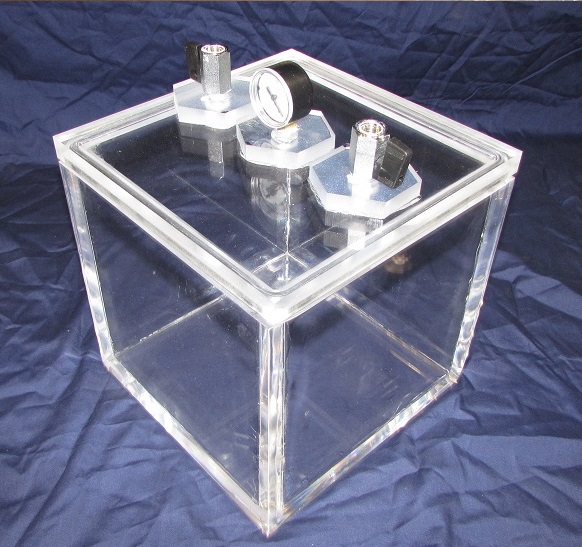
Generally speaking, the highest vacuum that you should expect in an acrylic vacuum chamber is about 0.1 Torr; you may go lower if you use a more powerful pump, but as stated above, acrylic is intended for low vacuum applications.
Vacuum Pump for an Acrylic Vacuum Chamber
The vacuum pump is the single most determinant of the vacuum levels you will achieve in your chamber. The air flow as well as the vacuum pump power will determine how fast and how high of a vacuum you will be able to pull. A good rule of thumb is to take the vacuum volume of the chamber and multiply that by 2.5. This will give you the CFM requirements of your vacuum pump.
Quick Vacuum Pump Requirement Calculation
For chamber volume of 1 cubic foot (28.13 Liters) or less, it is recommended to use a vacuum pump in the 1/4 HP to a 1/3 HP range and a flow rate of 1.5 cubic feet per minute (CFM) to 3.0 CFM. [Note: 1 cubic meter per hour is equal to 0.588577779 cubic feet per minute]. Higher vacuum volume will require a more powerful and a more flowing pump. Even though the pumps described in the paragraph above should work OK, it is recommended to implement a stronger pump. Pumps in the 1/2 HP to 3/4 HP and 3 CFM to 5 CFM will work for this range. For optimal performance, this vacuum volume will require pumps which are in the 3/4 HP and higher range and 7 CFM or higher.
You should reference the table below as a guide for your pump selection. Keep in mind that the table below is more of a rule of thumb than a gospel - you should contact us if you are not entirely sure which pump to use for your system application.
| Acrylic Chamber Volume (cubic feet) | Recommended Vacuum Pump CFM | Recommended Vacuum Pump Horsepower |
| Less than 1 | 3.0 or less | 0.25 (1/4) HP or more |
| 1 to 2 | 3.0 to 5.0 | 0.33 (1/3) HP or more |
| 2 to 4 | 5.0 to 7.0 | 0.50 (1/2) HP or more |
| 4 or more | 7.0 or more | 0.75 (3/4) HP or more |
Recommended Vacuum pump for Clear Vacuum Chamber
A Rotary Vane pump is the way to go in 99% of all systems involving an acrylic vac chamber - as simple as that. Just doing a quick google.com search on rotary vane pumps, you will find that your selection is endless.
The choice of vacuum pump is completely up to you. You must however balance your budged with performance because, as with all things in life, performance comes at a price. Depending on what vacuum level you intend to get and how fast you are looking to get down to a certain vacuum level you should consider the pumps below.
Contact us if you need help selecting your vacuum pump
We have done this long enough to know which pump will work with which acrylic vacuum chamber. You are very welcome to contact us with questions regarding vacuum pumps. And even though we neither carry nor sell vacuum pumps ourselves, we would be happy to assist you with your pump selection.
Some of our Popular Items
We are an Engineering Excellence Company. Check out some of our other items we carry that you can combine/integrate with your systems or projects.
Complete List of Articles Related to Acrylic Vacuum Chambers
